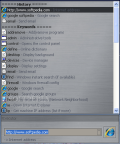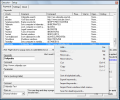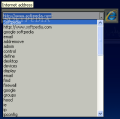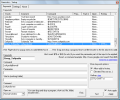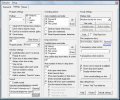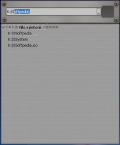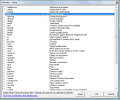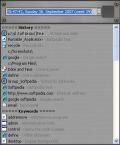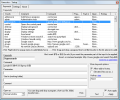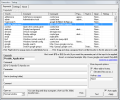When you work with many applications, you open tens of web pages and you need something that can help you gain time in accessing your files and folders; well, in that case, you might want to consider searching for a hotkey manager, shortcut creator, application launcher that can come in handy. There are plenty of software products to choose from. There are no rules that must be followed when it comes to this kind of software. Some of them are offering not only the basic quick access features, but also other miscellaneous tools that make them worth trying.
Hotkey creators and managers provide quick access to your files or applications and so do the launchers that can open websites in just a few mouse clicks. When you have a big amount of applications, files, websites that you need to open, close and manage, you need something that can offer not only the quick access and hotkey features but also the possibility to customize and create your own layouts.
Executor is an application that comes not only with the possibility to create hotkeys and launch applications, but it also includes other useful features. Executor was designed to help you launch applications, files, folders, commands using keywords. I guess the difference between launching your applications using keywords and launching your applications using hotkeys is that when you use keywords you can set your own particular name for an application. For example: if you work more often with Windows Explorer, you develop a certain routine towards it and you can create your own particular keyword for it.
For every keyword that you create you can assign a hotkey, so that you will be able to execute the command without calling the Executor and entering the keyword. There are more than one ways to create keywords. The first one is the simplest and most effective. Executor comes with an option which, once it has been enabled, it will give you the possibility to create the keyword by choosing the "Send to Executor" line from the context menu. The option is called Add to Windows "Send to" menu and is located under the Window settings tab.
The second method is the 'drag and drop' over the Executor main window. After this, the new keyword window will appear and will let you customize the keyword. A third method would be to create the keyword directly from the Keywords window list. Press the insert button or right click on an existing keyword and choose add from the menu.
After you create the keyword, you have to enter the command line, the parameters, set in what directory you want to start from, add an optional comment text or set the window behavior. When creating a new keyword you have two possibilities to add the file, folder, application that you want to open with the keyword. Simply drag and drop the file over the window or press the Find button to browse and select the file. The extra keyword options will allow you to enable the "add to history" or "elevate options" which is similar to run file with administrative rights on Vista.
Every created keyword can be tested in advance by pressing the Test button, which I think can be very useful when you create keywords and add different types of parameters that can influence the command execution.(Some changes need restart to take effect) For example: create a new keyword and enter a command text. For the command parameters, the producer provides a list with special commands that you can add to adjust and modify the command behavior. The next question is if the Executor can open multiple files or applications. After you create a set of keywords, you can open more than one per instance. Create a new keyword and, in the command line enter the keywords that you want to open but separate them with "||".
I must say that the producer offers lots of details on the help web page that are useful in customizing the keywords. By default, Executor comes with a list of keywords already created such as: control panel options, system power options, network options, Google search, Google Group search, YouTube, Wikipedia, or IMDB search, or default media player controls. Every keyword can be exported or you can also import keyword files.
One strong element of Executor is that it scans the Start menu items and lets you choose the ones you want to add to your list. True and extremely useful, but considering the fact that it comes in a zip archive too that requires no installation and can run from a portable device too, I think that it would be great to have the possibility to define the scan area. Meaning that not only are you able to scan the start menu items but also another directory (e.g. the flash drive directory where you have your portable applications). This is overcome by the fact that you can add keywords that define applications from your portable drive, but be sure to replace the drive letter with the $D$ parameter in the command line. (e.g. K:SoftpediaSoftpedia.exe will become $D$SoftpediaSoftpedia.exe).
I've noticed that although I unzipped the no installation version file to a separate directory to my portable drive and ran it and made a few changes, Executor created a directory with the INI file at C:Document and SettingsUsernameApplication DataExecutor. Create a new .INI file, copy the data from the one in the AppData, put the file in the root Executor directory, restart the application, and here you have your potable version.
I created a small test upon the provided documentation: add a new keyword and in the command field enter google||ip. Executor opened the Google search window and in the main window, it showed my IP address. So far so good. I created a new keyword called "supersearch" to test the next example from the documentation where the keyword command line is google $U$||wiki $U$||youtube $U$|| group$U$ and entered "supersearch softpedia" in the run field; the result was that it opened the Google, Wiki, Youtube search window with the word "Softpedia" as search string in three different web-browser windows, but not in default web-browser.
Now I asked myself: 'What is going to happen if I create two keywords with the same name and input the name in the run window?'. I tried that too, and the result was that Executor executed the first one and ignored the second one. The next test was to input a non-existing keyword. The result is that the text is changing its color to red. When adding a new keyword, the name must not contain any spaces.
Starting with the 0.96 version, Executor can create a new keyword formed by more than one word. But it must be separated by comma. The application comes by default with some internal keywords that you can use to work easier with your PC. Type "time" in the keyword box and it will show you a line with the current time and date. Some of these internal commands must be entered using the "?" symbol in front. But if you type "?" in the keyword box, a list with all the commands will appear and you can select the one you want.
The Keyword box has the autofill feature enabled so that you don't have to write the whole word. Just type one or two letters and Executor will show a list with all the keywords matching your letters. Executor comes in many shapes and skins that can be customized from the settings menu and saved as new skins. You will be able to adjust the transparency level to create a new skin. If you modify the preference upon the Settings window, it will save it automatically, meaning that there is no Apply or OK button to save, but it does have the Restore Default Settings window.
One thing that I couldn't figure out was how to make Executor open an URL address in the default browser. It opens the address, but in Internet Explorer; and if you have more than one address that you want to open, it will fill your task bar with IE windows. The Settings window lets you customize the application behavior as well as keywords behavior.
The Good
Executor comes with a lot of options to choose from and it lets you customize any keyword individually. Even if you are running the application from a portable device, you will be able to search for applications from the local start menu. It includes keywords and hotkeys for every item you add.
The Bad
I think that it would make a great difference if Executor had the possibility of scanning a specified folder, directory for programs like it does for the start menu. Open URL in default browser option must be added too and making Executor open keywords at startup can be a plus.
The Truth
The software is offering keywords that are much easier to assign than hotkeys, plus, we also have the bundle of application behavior settings and other miscellaneous commands, so I would say that Executor can be a really good candidate when it comes to deciding which application launcher suits us best.
Here are some snapshots of the application in action:
 14 DAY TRIAL //
14 DAY TRIAL // 
